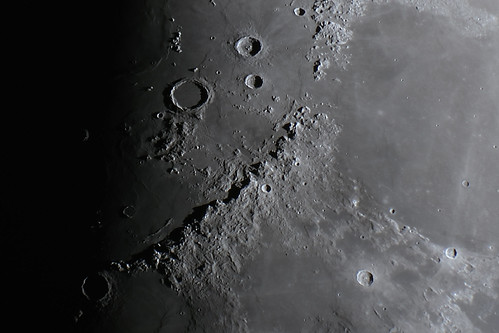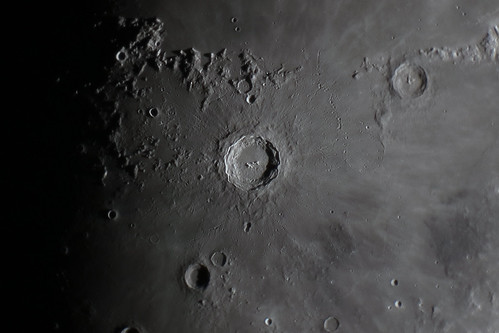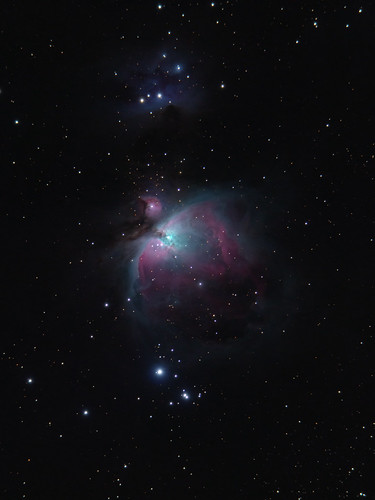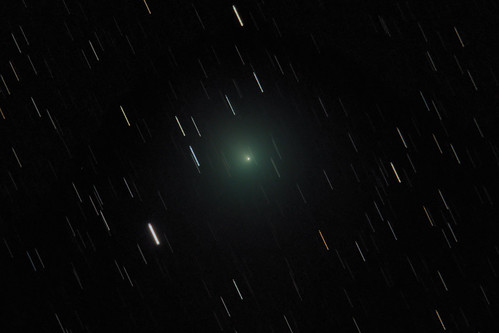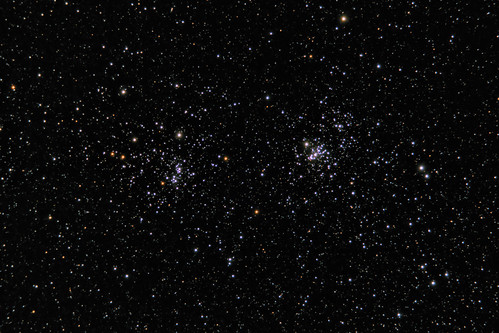10 February 2019, 20:15 – 23:15
Conditions: Cold, but not freezing; light wind. Some interference from the crescent moon, but the transparency improved considerably once it got out of the way. Only meant to stay out for 90 minutes, but it turned into something of a marathon session.
Began with a low-power sweep across Auriga, stumbled upon
M37: rich, lovely cluster. 50x really shows the cluster in context of its surroundings, at the expense of the fainter stars.
Then revisited some old favourites to test a new
Astronomik OIII filter:
M42, Orion Nebula: western section greatly filled in. View similar to Ultrablock, but even more contrast between nebula and surrounding sky.
M1, Crab Nebula: OIII made it bigger; the edges seemed “crisper” and more defined, but as always, the Crab is one of those telescopic objects where expectation far exceeds reality.
Rosette Nebula: nebulosity more evenly distributed around cluster, more expansive.
Eskimo Nebula: very bright in OIII, overwhelming the central star.
M97, Owl Nebula: The OIII really benefits this planetary nebula, transforming it into a bright disc with sharper edges. Averted vision brings out the two dark cavities (the Owl’s “eyes”). Faint star adjacent to nebula. Otherwise there’s not much to choose between this (the OIII) and the Ultrablock, but still a huge improvement on the unfiltered view.
NGC 2022, planetary nebula in Orion
Small annulus of light, seemed to have brighter patches on opposite sides. Compared to previous observation, the OIII filter made it look even more like a mini M57.
NGC 2420, open cluster in Gemini
Rich, condensed mixture of directly resolved stars and underlying haze that resolves with averted vision. Brighter stars form a rough outline resembling a three-legged spiral or a propeller with swept-back blades.
NGC 2371-2, planetary nebula in Gemini
Small, elongated, bi-lobed nebula, like two tiny comets travelling in opposite directions. One lobe appeared slightly brighter than the other, with suggestion of a condensed core.
NGC 2683, galaxy in Lynx
Bright, lens-shaped galaxy. Suggestion of mottling around core and dark lane to north.
NGC 2775, galaxy in Cancer
Not as bright as 2683, but rounder, more face-on than previous galaxy. Averted vision shows stellar nucleus.
M67, open cluster in Cancer
Rich, fully resolved at 133x, though would probably look better at lower magnification to provide context.
M41, open cluster in Canis Major
Quick look: rich, sprawling cluster, bright stars forming curved lines. Unfortunately hampered by low altitude (-20 degrees declination) and local light pollution.
NGC 2903, galaxy in Leo
Large and bright as non-Messier galaxies go. Extended envelope surrounding bright core, with suggestion of at least one spiral arm. Slightly ragged appearance – arms not tightly wound, so in that sense intermediate between M81 and M33.
M95, M96, M105, NGC 3384, NGC 3412 and NGC 3377, galaxies in Leo
This was a pleasant surprise after the trouble I had picking out faint galaxies last autumn. A casual sweep of the area revealed six bright galaxies all within a few degrees of each other. M105 and NGC 3384 formed a close pair; M95 and M96 a wider pair. Initial impressions: all six galaxies showed condensed star-like cores and faint outer envelopes, with individual variations in size, brightness and roundness. M95 and M96 looked like they might show more detail with prolonged observation.
NGC 3190 and NGC 3193, galaxies in Leo
The atlas showed this pair positioned halfway between two naked-eye stars in the head of the lion – Gamma and Zeta Leonis (Algieba and Adhafera), so I knew I wouldn’t have to waste too much time sweeping the area. As it turned out, they showed up really well in the XT10. Smaller and fainter than previous set, but a pleasingly contrasting pair of galaxies in a star-rich fov. One circular, other edge-on, like mini version of M81 and M82.
NGC 3226 and NGC 3227, galaxies in Leo
As before, another easy star-hop from Gamma Leonis (Algieba). Slightly fainter than previous pair. Very close pair of galaxies, arranged end to end, long axes aligned. Condensed cores.
M65 and M66, galaxies in Leo
Larger, brighter than the M95/M96 pair, but the outer regions have lower surface brightness. Averted vision suggested brightness variations around the nuclei.
NGC 3628, galaxy, Leo
Third member of the Leo Triplet: faint bar of light perpendicular to M65/M66 pair. No central condensation; possible distortion/hook at one end? This galaxy (and the previous pair) was still fairly low down when I observed it – with higher altitude I might be able to see the dark lane.
M51 & NGC 5195, Whirlpool Galaxy in Canes Venatici
In a night of highlights, this was the undoubted stand-out. After staring at M51 for a couple of minutes I realised I could see the spiral arms quite clearly, defined by the dark space separating them. One arm curling out from core region around a foreground star. A magnificent sight at 133x, even though it was still some way from the zenith. With averted vision it started to look like a ghostly monochrome photo. A sketch might be in order.
M101, spiral galaxy in Ursa Major
Faint, hard to find (again). Hint of spiral structure, but my eyes were starting to feel tired by now.
M82, cigar galaxy in Ursa Major
Extended streak of light tapering to points at either end. High surface brightness, lots of detail in the form of bright condensations and dark dust lanes and notches. Best edge-on galaxy by far. Again, another sketch might be in order.
M81, spiral galaxy in Ursa Major
Bright core, extensive outer region. Possible dark patches near nucleus, but my eyes were getting really tired now, so time to call it a night.
Nature note
Two frogs mating in the pond. I guess it’s never too early…





